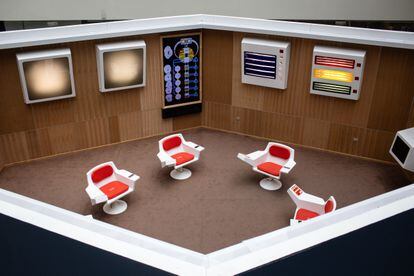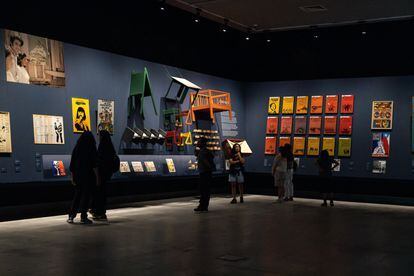Under the Plaza de la Ciudadanía, in front of the south façade of the Presidential Palace of La Moneda, in Santiago, Chile, those who appreciate history and art can find a treasure. The exhibition How to design a revolution. The Chilean way to design, mounted in the basement of the center of the capital, in the La Moneda Cultural Center, hides true gems of the role that design played in the Popular Unity of Salvador Allende (1970-1973). For the first time, a synthesis of the posters, editorials, furniture, record collections and even the spoons that were made for the campaign is presented. Half a liter of milk daily for the boys and girls of the country during that time. The curators Eden Medina, Hugo Palmarola and Pedro Ignacio Alonso, present this Tuesday a book of the same name, published by the Swiss publishing house Lars Müller Publishers, as an extension of the exhibition. It is a complete record and analysis of the graphic and industrial design projects of the Allende era.
American researcher Eden Medina, associate professor of science, technology and society at the Massachusetts Institute of Technology (MIT), began investigating the project 20 years ago. Cybersyn, a revolutionary technological bet that sought to control economic information coming from all corners of Chile during the Popular Unity. The author of Technology and politics in Salvador Allende's Chile (LOM Ediciones) met the designer Hugo Palmarola, from the Catholic University, who was also researching Cybersyn, as part of the projects carried out by the Technological Research Committee. Thinking about the 50 years since the commemoration of Augusto Pinochet's coup d'état, last September, they decided to put together an original, innovative exhibition, where the protagonist was the explosion of creativity that marked Allende's mandate. “We knew that there was another interpretation of history, of Popular Unity, and that it was the design,” says Palmarola in a tour of the exhibition.
The exhibition – a joint work of the Catholic University, MIT and Centro Cultural la Moneda – brings together more than 350 pieces, most of them original, from political projects developed between 1970 and 1973, many of them linked to nutrition or music, escaping from what is known about the campaigns. The core themes were the care of the population and children, in contrast to the high technology of Cybersyncwhose operations room is meticulously replicated just outside the exhibit, where visitors can experience how they sought to collectively control the economy across the country.
The main image of the exhibition, which is also the cover of the book, is a woman hugging faceless adults and children, based on a poster by designers Waldo González and Mario Quiroz. She was chosen because she conveys the idea of a collective project rather than that of a leader directing a political process. “One of the criticisms made to the Unidad Popular is the focus they put on the men in the field, from the unions, when women may not appear as much in photos and posters. But the exhibition shows that they were actors in terms of creators of the program and how they imagined the revolution,” Medina points out.

The context of how the projects impacted and coexisted with the society of that time plays a key role in the exhibition with images by photographers, mainly foreigners, such as the American Ted Polumbaun, the German Leonor Mau or the Portuguese Armindo Cardoso. The effort to democratize art is reflected in how posters and murals plastered cities throughout the country, with the desire that the entire society could have access to works of graphic design. For the first time, the complete original collection of the Discoteca del Cantar Popular (DICAP), a record label that emerged between 1967 and 1973, from the Communist Youth of Chile, is on display. The albums by Inti Illimani and Quilapayún appear, for example, with covers designed by the brothers Vicente and Antonio Larrea, enormously recognized for their work on posters, more than for their side linked to music.
There are real gems. As the only remaining copy of the 18 poster designs to support the anti-fascist days to prevent a coup d'état and civil war. 9,000 copies were made of the pieces made by designers from the graphic workshop of the State Technical University, one of the focuses of repression after the democratic breakdown of 1973. They destroyed all of them, except for the one on display, the curators say. “Each object in this exhibition has a 50-year survival story. Each object has its own history and its own difficulty of being here. It is very significant,” says Medina.
The bulk is original, but in the case of extinct posters, such as some from the copper nationalization campaign, the curators worked together with the cartoonist Hernán Vidal, known as Hervi, to reconstruct them. One of the most notable efforts to replicate the objects of the time is the wall where the furniture designed specifically for the National Board of Kindergartens (Junji) is displayed, created in 1970. Some colored chairs and tables built based on geometric figures , with ergonomic measures, statically admirable. They were made by the same people who designed the ultra-avant-garde room Cybersyn. With the scraps of furniture they made everything from wooden toys to cribs.

“Just as the ideal of a new man existed in the socialist bloc, we propose in this curatorship that infrastructure is also for the new kid”, maintains Palmarola. An example of this is the milk measuring spoon for infants. The exhibition can be seen on the enormous walls. But the spoon is displayed in the center of the room, as the heart of the proposal. “Here the technical or scientific nutrition project is mixed with the political project,” adds the designer from the Catholic University. The object, as it could not be otherwise, is complemented by the posters and photographs that accompanied the campaign.
The most significant stories of the design experience lived in Unidad Popular are told in the book How to design a revolution. The Chilean way to design –translated into Spanish and English– which is launched this Tuesday in Santiago, on Thursday in Chillán, on Saturday in Concepción and on January 25 in Valparaíso.

Subscribe here to the EL PAÍS Chile newsletter and receive all the key information on current events in the country.
#Posters #records #spoons #revolutionary #design #Allende39s #Popular #Unity